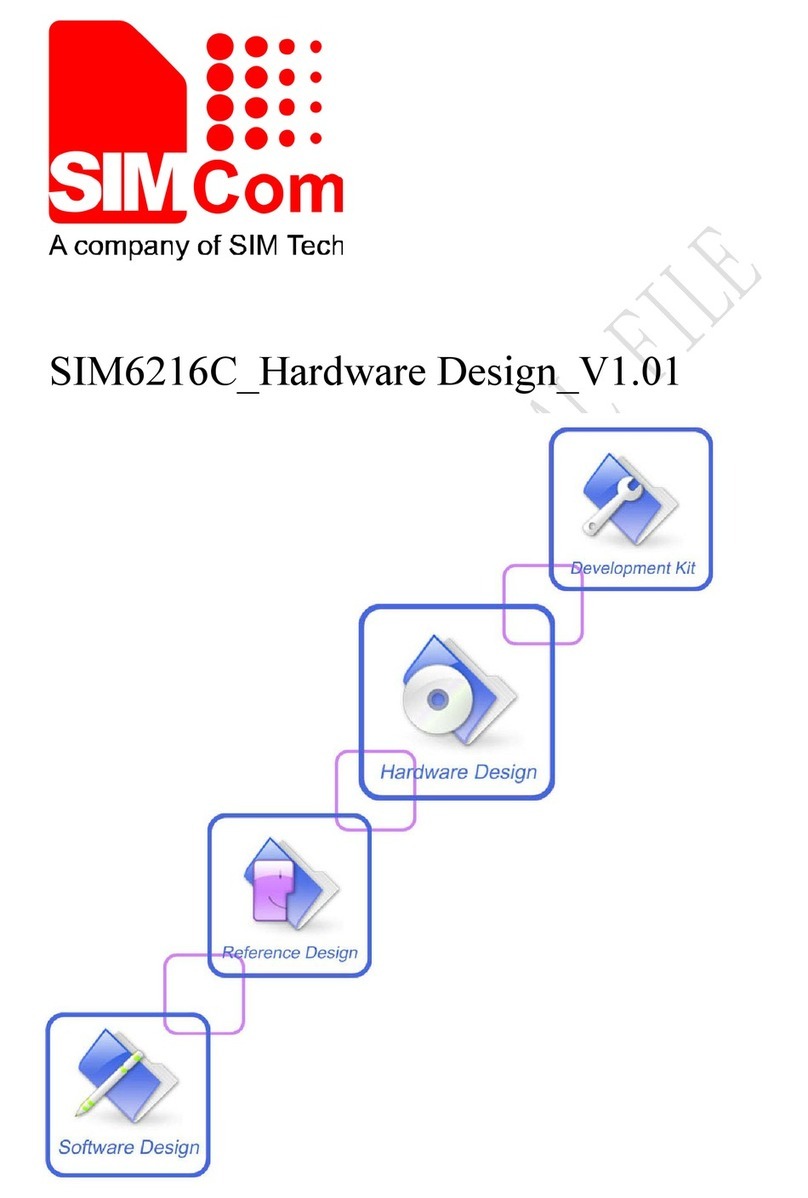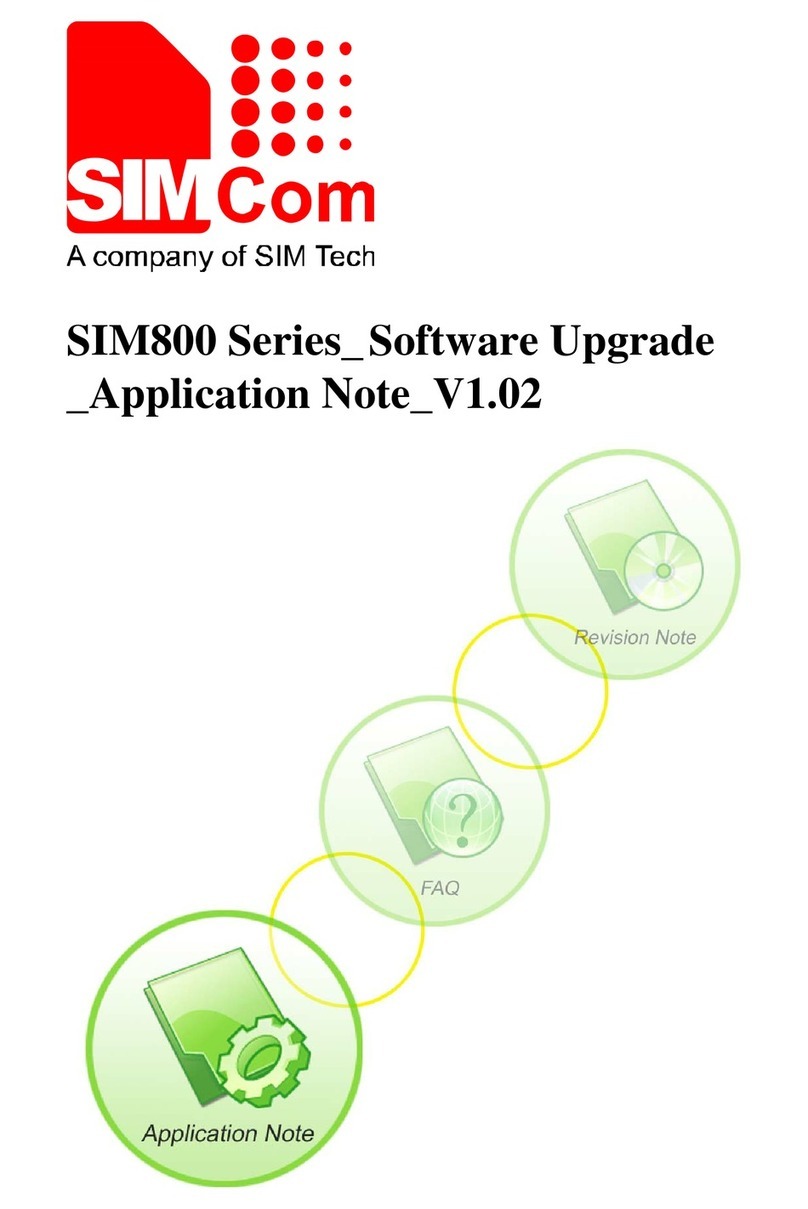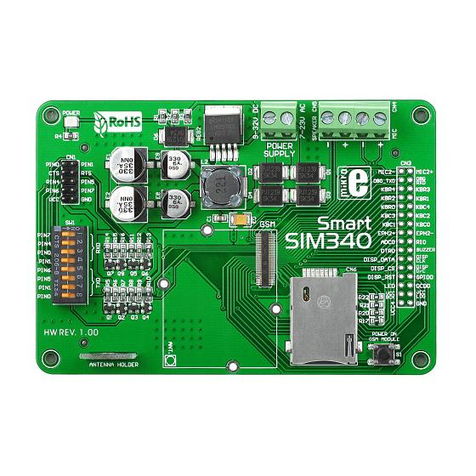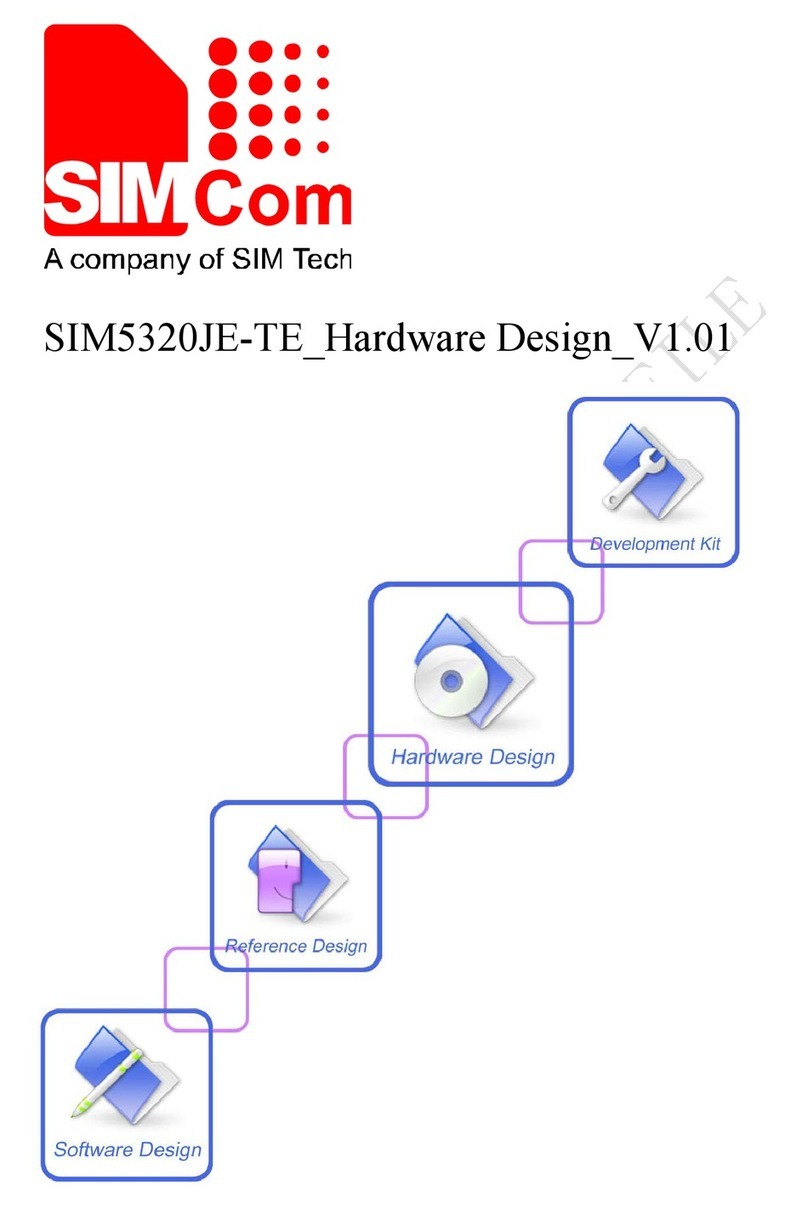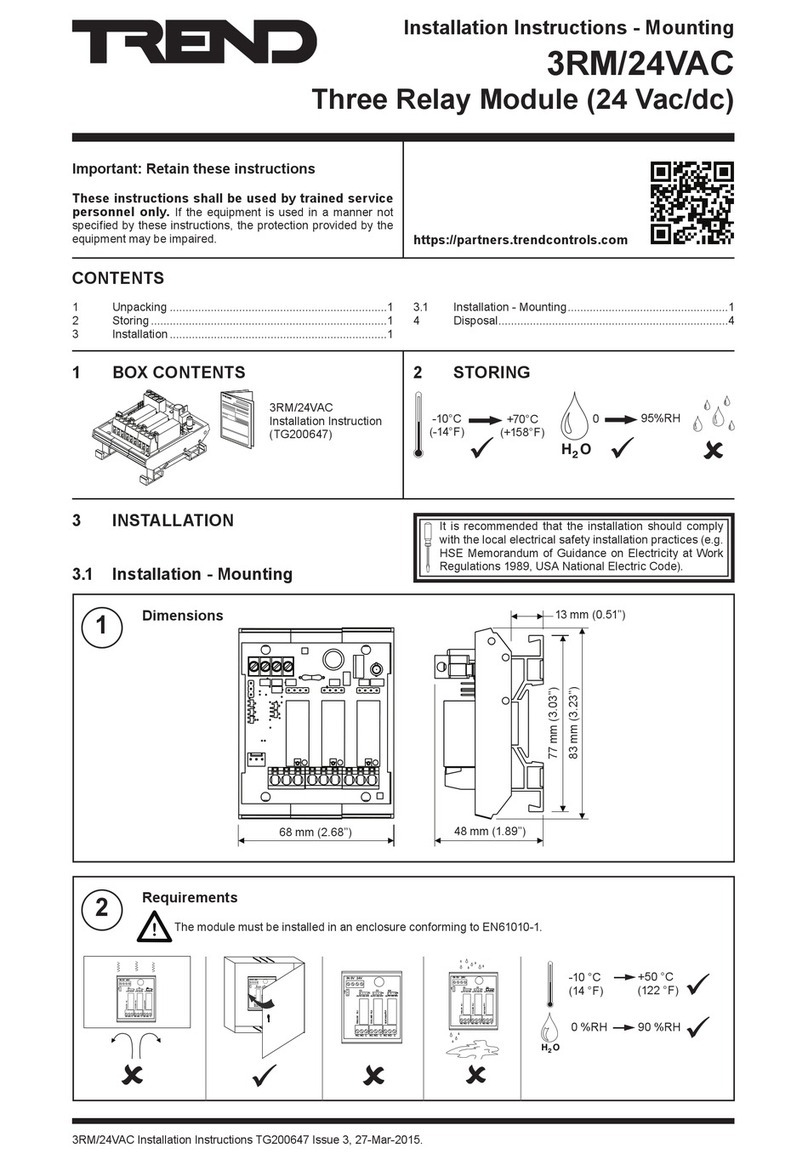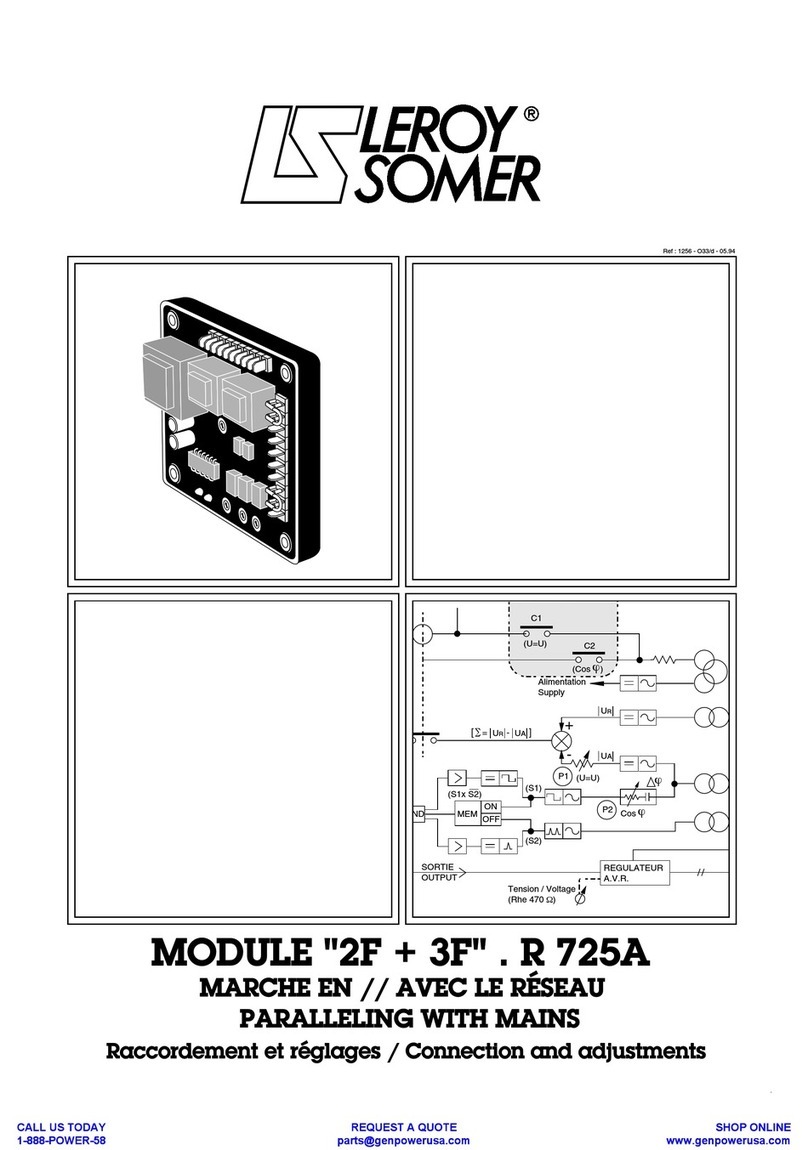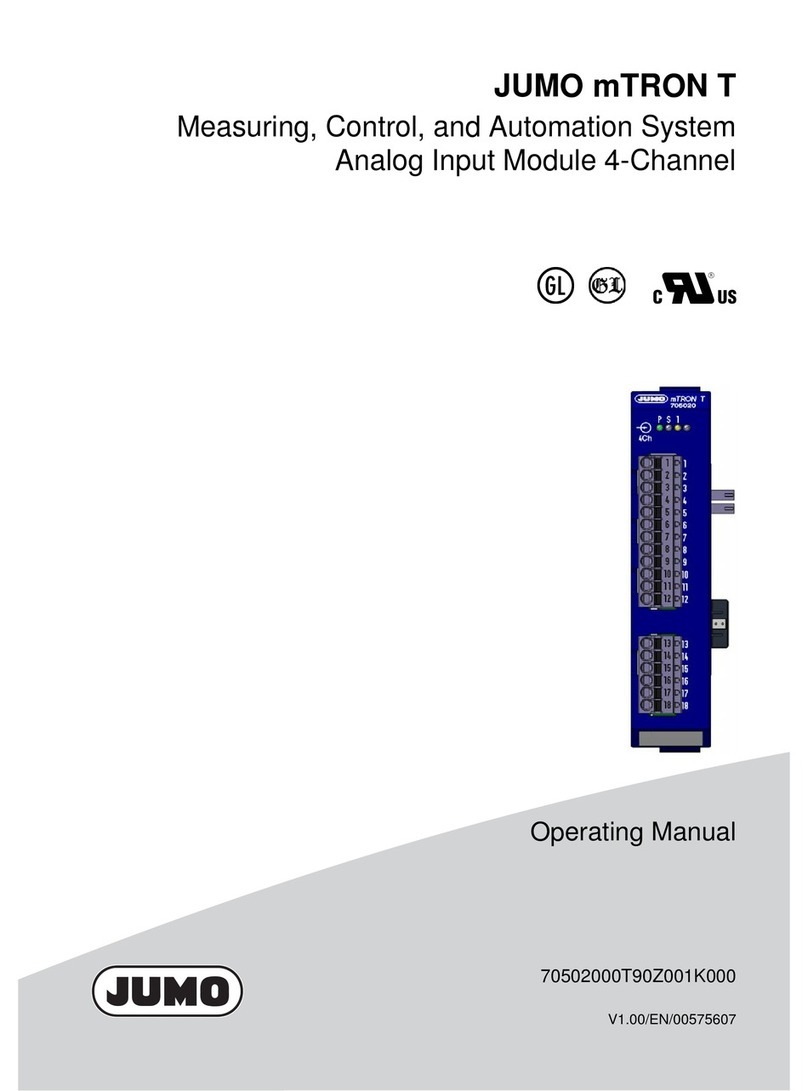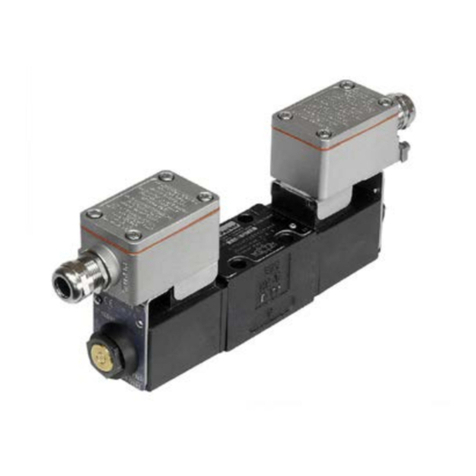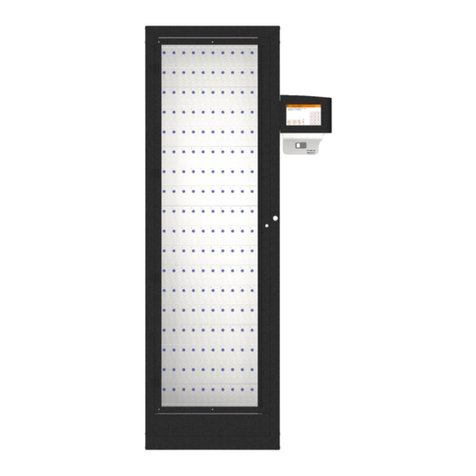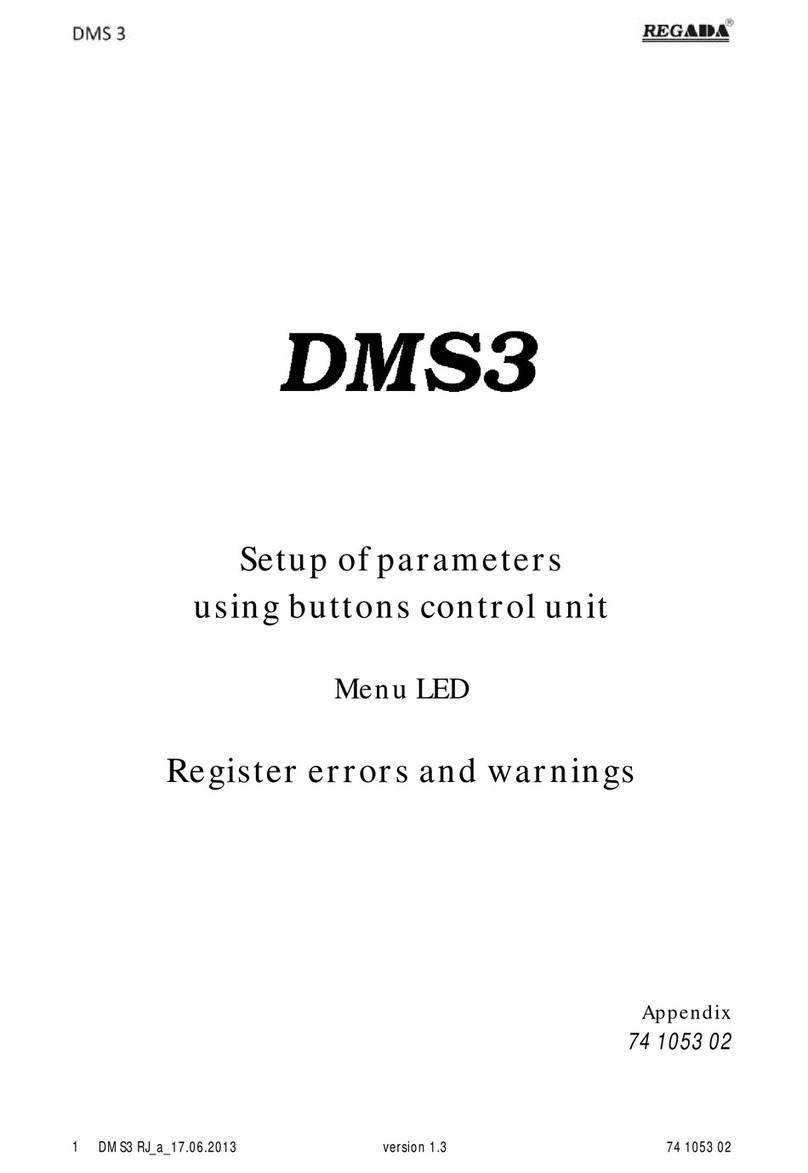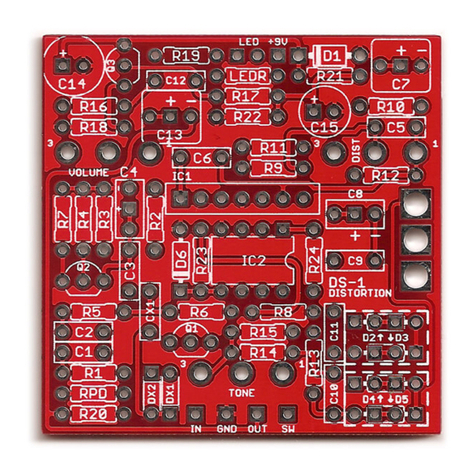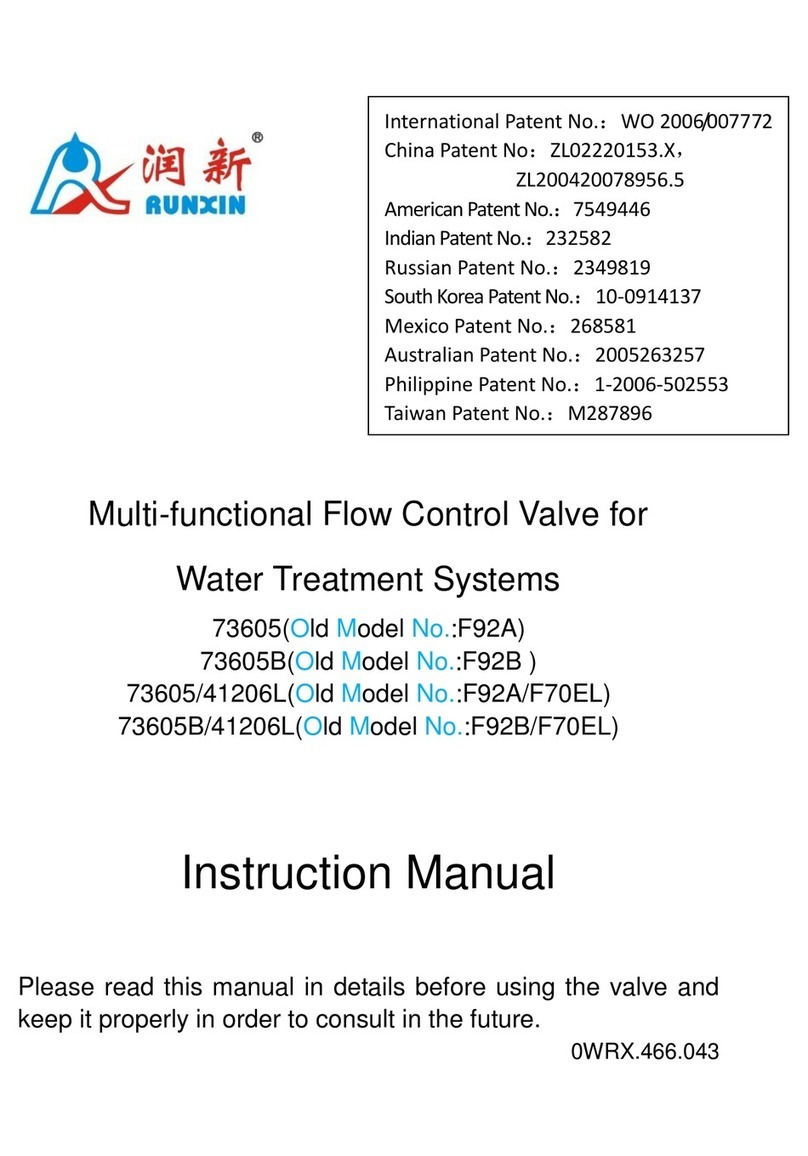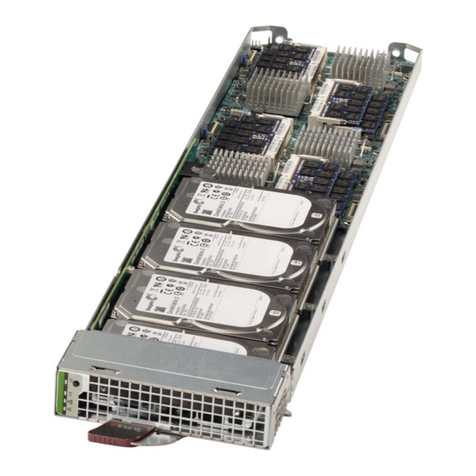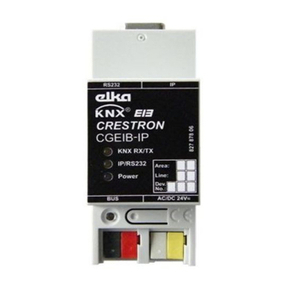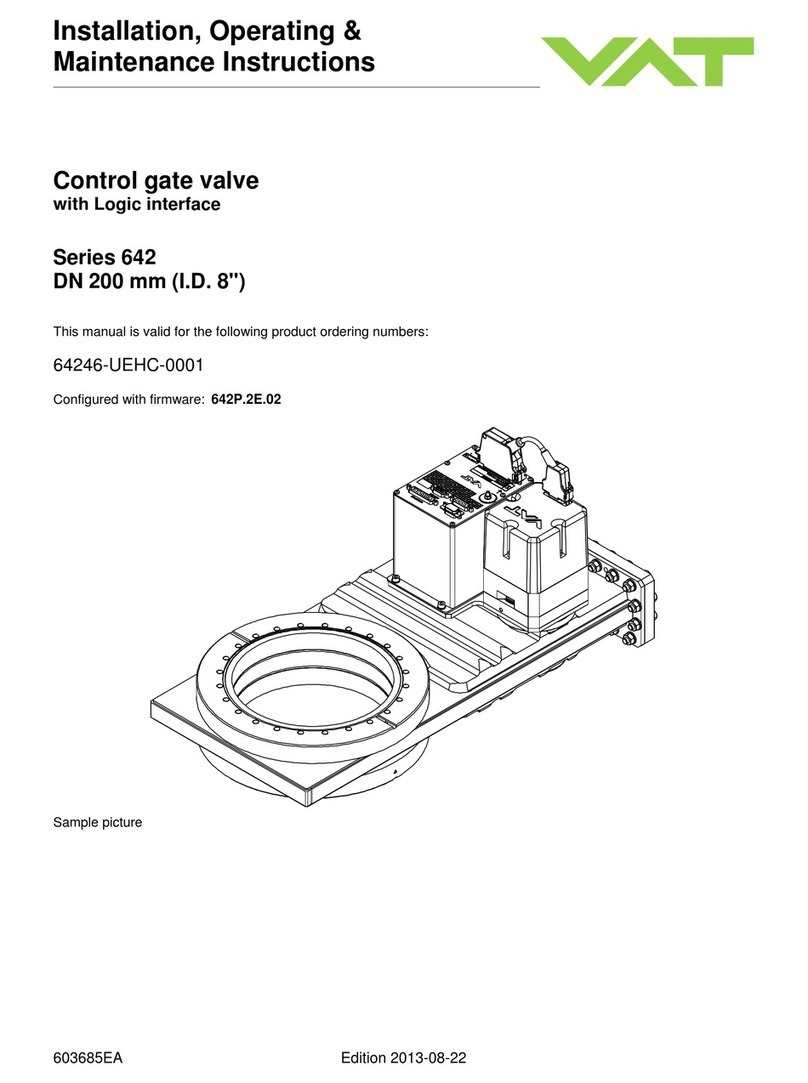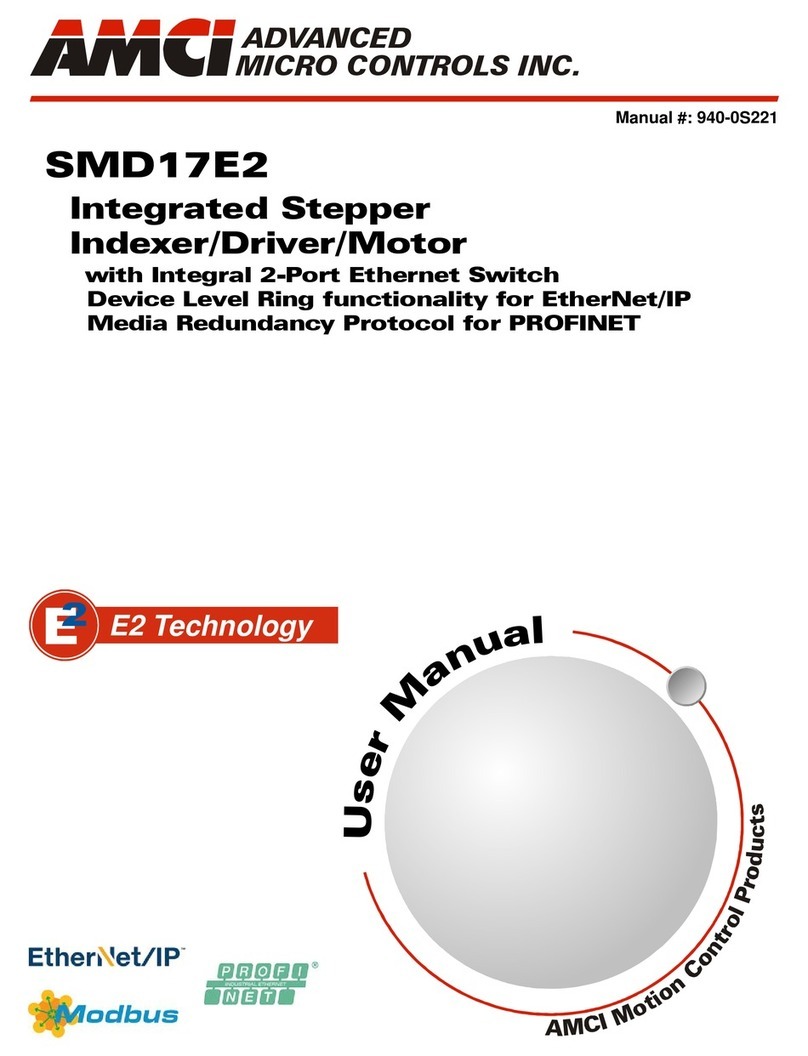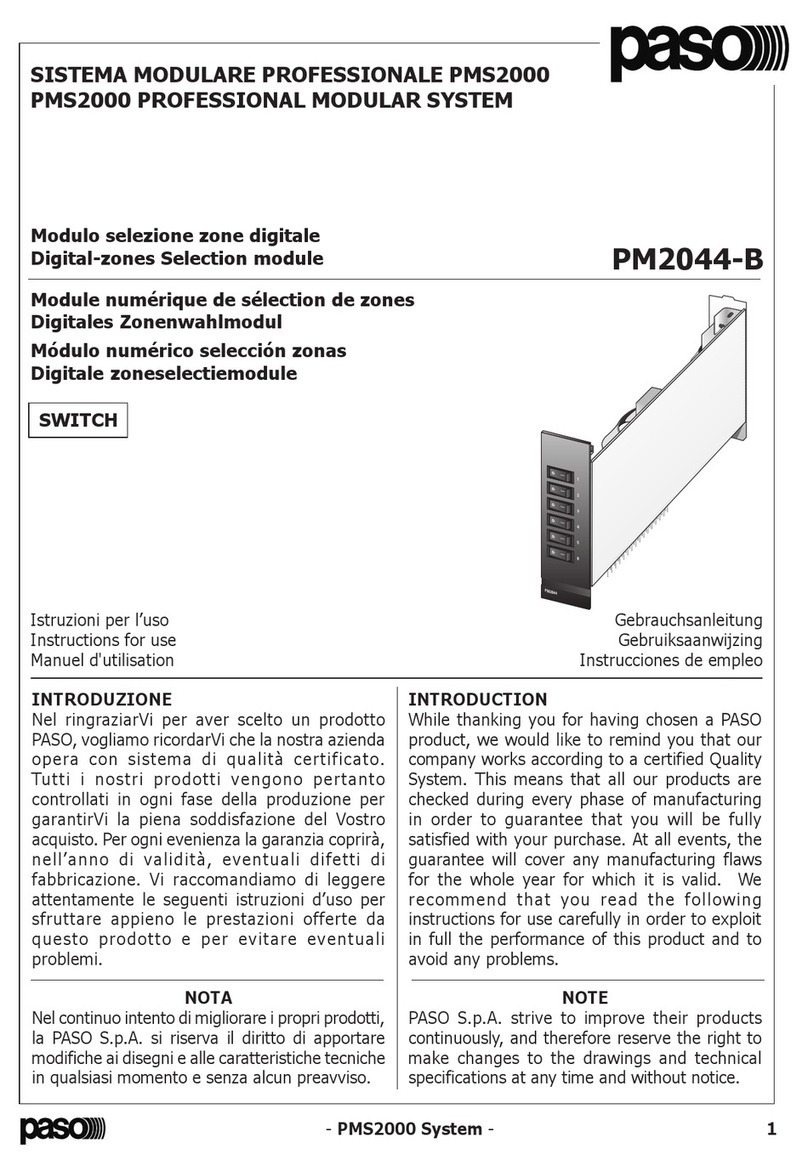SimTech SimCom SIM5218E Supplement

SIM5218E_Hardware
Design_V1.06

Document Title: SIM5218E Hardware Design
Version: 1.06
Date: 2012-109-21
Status: Release
Document Control ID: SIM5218E_ Hardware_Design_V1.06
General Notes
SIMCom offers this information as a service to its customers, to support application and
engineering efforts that use the products designed by SIMCom. The information provided is based
upon requirements specifically provided to SIMCom by the customers. SIMCom has not
undertaken any independent search for additional relevant information, including any information
that may be in the customer’s possession. Furthermore, system validation of this product designed
by SIMCom within a larger electronic system remains the responsibility of the customer or the
customer’s system integrator. All specifications supplied herein are subject to change.
Copyright
This document contains proprietary technical information which is the property of SIMCom
Limited., copying of this document and giving it to others and the using or communication of the
contents thereof, are forbidden without express authority. Offenders are liable to the payment of
damages. All rights reserved in the event of grant of a patent or the registration of a utility model
or design. All specification supplied herein are subject to change without notice at any time.
Copyright © Shanghai SIMCom Wireless Solutions Ltd. 2012

SIM5218E Hardware Design
SIM5218E_ Hardware Design_V1.06 2012.09.21
2
Version history
Data Version Description of change Author
2009-02-13 01.00 Origin
2009-03-24 01.01 Add depiction of analog sensor support in camera
interface chapter aaron
2009-05-31 01.02 Add depiction of DCD and DTR function in serial
interface chapter aaron
2009-6-5 Update the top and bottom pictures
Update the temperature Spec Chen
2009-6-11 Update the description of Band VIII
2010-10-27 01.04 Add RESET timing and module is waked up by DTR
signal description, modify PCM interface description,
HKADC description and UART referenced circuit.
Libing
2010-11-10 01.05 Add condition description about module entering sleep
mode automatically and AK8856 reference circuit. Libing
2012-09-21 1.06 Delete the chapter of Automatic power on. Modify
UART chapter. Libing

SIM5218E Hardware Design
SIM5218E_ Hardware Design_V1.06 2012.09.21
3
Contents
Version history ...........................................................................................................................................................2
1 Introduction............................................................................................................................................................. 5
1.1 Related documents ..............................................................................................................5
1.2 Terms and abbreviations......................................................................................................6
2 Product concept....................................................................................................................................................... 9
3 Application interface............................................................................................................................................. 13
3.1 SIM5218E pin description ................................................................................................14
3.2 Operating modes ...............................................................................................................17
3.3 Power supply.....................................................................................................................19
3.3.1 Power supply pins on the board-to-board connector .......................................................................20
3.3.2 Minimizing power losses ................................................................................................................ 20
3.3.3 Monitoring power supply ................................................................................................................ 20
3.4 Power up and power down scenarios ................................................................................20
3.4.1 Turn on SIM5218E..........................................................................................................................20
3.4.2 Turn off SIM5218E .........................................................................................................................21
3.5 Power saving .....................................................................................................................22
3.5.1 Minimum functionality mode.......................................................................................................... 22
3.5.2 Flight mode ..................................................................................................................................... 23
3.5.3 Sleep Mode ..................................................................................................................................... 23
3.5.4 Wake up SIM5218E from Sleep Mode............................................................................................ 24
3.6 RTC backup.......................................................................................................................24
3.7 Serial interface ..................................................................................................................26
3.8 Audio interfaces ................................................................................................................29
3.8.1 Speaker interface configuration....................................................................................................... 30
3.8.2 Microphone interfaces configuration .............................................................................................. 31
3.8.3 Earphone interface configuration ....................................................................................................32
3.8.4 Referenced electronic characteristic................................................................................................32
3.8.5 Programming characteristic............................................................................................................. 33
3.9 USIM card interface..........................................................................................................36
3.9.1 USIM card application ....................................................................................................................36
3.9.2 Design considerations for USIM card holder ..................................................................................38
3.9.3 Embedded SIM card IC...................................................................................................................38
3.10 I2C interface....................................................................................................................39
3.11 High speed USB interface...............................................................................................39
3.12 Module Reset ..................................................................................................................40
3.13 General purpose input & output (GPIO).........................................................................40
3.14 ADC interface .................................................................................................................42
3.15 LDO power output ..........................................................................................................43

SIM5218E Hardware Design
SIM5218E_ Hardware Design_V1.06 2012.09.21
4
3.16 Camera module interface ................................................................................................44
3.17 MMC/SD card interface..................................................................................................46
3.18 Global Positioning System (GPS)...................................................................................48
3.18.1 GPS modes.................................................................................................................................... 48
3.18.2 Using GPS by NMEA port ............................................................................................................49
3.18.3 Technical data................................................................................................................................49
3.18.4 GPS operate................................................................................................................................... 50
3.19 PCM Interface .................................................................................................................50
3.19.1 Auxiliary PCM .............................................................................................................................. 52
3.19.2 Primary PCM ................................................................................................................................53
3.19.3 Transmitting PCM data by USB....................................................................................................55
4 Antenna interface .................................................................................................................................................. 55
4.1 Antenna installation...........................................................................................................55
4.1.1 Antenna connector........................................................................................................................... 55
4.1.2 Antenna pad..................................................................................................................................... 56
4.2 Module RF output power ..................................................................................................56
4.3 Module RF receive sensitivity ..........................................................................................57
4.4 Module operating frequencies...........................................................................................57
5 Electrical, reliability and radio characteristics ...................................................................................................... 57
5.1 Absolute maximum ratings ...............................................................................................57
5.2 Operating temperatures .....................................................................................................58
5.3 Power supply ratings.........................................................................................................58
5.4 Current consumption.........................................................................................................59
5.5 Electro-Static discharge.....................................................................................................61
6 Mechanics............................................................................................................................................................. 63
6.1 Mechanical dimensions of SIM5218E ..............................................................................63
6.2 Mounting SIM5218E onto the application platform .........................................................64
6.3 Board-to-board connector .................................................................................................65
6.4 RF connector and adapter cable ........................................................................................66
6.5 View of the SIM5218E......................................................................................................67
6.6 PIN assignment of board-to-board connector of SIM5218E.............................................68

SIM5218E Hardware Design
SIM5218E_ Hardware Design_V1.06 2012.09.21
5
1 Introduction
This document describes the hardware interface of the SIMCom SIM5218E module that connects
to the specific application and the air interface. As SIM5218E can be integrated with a wide range
of applications, all functional components of SIM5218E are described in great detail.
This document can help user quickly understand SIM5218E interface specifications, electrical and
mechanical details. With the help of this document and other SIM5218E application notes, user
guide, user can use SIM5218E module to design and set-up mobile applications quickly.
1.1 Related documents
Table 1: Related documents
SN Document name Remark
[1] SIMCOM_SIM5218_A
TC_EN
SIMCOM_SIM5218_ATC_EN
[2] ITU-T Draft new
recommendationV.25ter
:
Serial asynchronous automatic dialing and control
[3] GSM 07.07: Digital cellular telecommunications (Phase 2+); AT command
set for GSM Mobile Equipment (ME)
[4] GSM 07.10: Support GSM 07.10 multiplexing protocol
[5] GSM 07.05: Digital cellular telecommunications (Phase 2+); Use of Data
Terminal Equipment – Data Circuit terminating Equipment
(DTE – DCE) interface for Short Message Service (SMS) and
Cell Broadcast Service (CBS)
[6] GSM 11.14: Digital cellular telecommunications system (Phase 2+);
Specification of the SIM Application Toolkit for the Subscriber
Identity Module – Mobile Equipment (SIM – ME) interface
[7] GSM 11.11: Digital cellular telecommunications system (Phase 2+);
Specification of the Subscriber Identity Module – Mobile
Equipment (SIM – ME) interface
[8] GSM 03.38: Digital cellular telecommunications system (Phase 2+);
Alphabets and language-specific information
[9] GSM 11.10 Digital cellular telecommunications system (Phase 2);Mobile
Station (MS) conformance specification;Part 1: Conformance
specification
[10] 3GPP TS 51.010-1
Digital cellular telecommunications system (Release 5); Mobile
Station
(MS) conformance specification
[11] 3GPP TS 34.124
Electromagnetic Compatibility (EMC) for mobile terminals and
ancillary equipment.
[12] 3GPP TS 34.121
Electromagnetic Compatibility (EMC) for mobile terminals and
ancillary equipment.

SIM5218E Hardware Design
SIM5218E_ Hardware Design_V1.06 2012.09.21
6
[13] 3GPP TS 34.123-1
Technical Specification Group Radio Access Network; Terminal
conformance specification; Radio transmission and reception
(FDD)
[14] 3GPP TS 34.123-3
User Equipment (UE) conformance specification; Part 3:
Abstract Test Suites.
[15] EN 301 908-02 V2.2.1
Electromagnetic compatibility and Radio spectrum Matters (ER
M
Stations (BS) and User Equipment (UE) for IMT-2000. Third Ge
n
cellular networks; Part 2: Harmonized EN for IMT-2000, CDMA
D
Spread (UTRA FDD) (UE) covering essential requirements of art
i
of the R&TTE Directive
[16] EN 301 489-24 V1.2.1
Electromagnetic compatibility and Radio Spectrum Matters
(ERM); Electromagnetic Compatibility (EMC) standard for
radio equipment and services; Part 24: Specific conditions for
IMT-2000 CDMA Direct Spread (UTRA) for Mobile and
portable (UE) radio and ancillary equipment
[17] IEC/EN60950-1(2001)
Safety of information technology equipment (2000)
[18] 3GPP TS 51.010-1
Digital cellular telecommunications system (Release 5); Mobile
Station (MS) conformance specification
[19] GCF-CC V3.23.1
Global Certification Forum - Certification Criteria
[20] 2002/95/EC Directive of the European Parliament and of the Council of 27
January 2003 on the restriction of the use of certain hazardous
substances in electrical and electronic equipment(RoHS)
[21] SIM52xx_Audio_Appli
cation_Note_V1.01
SIM52xx_Audio_Application_Note_V1.01
[22] SIM52xx_PCM_Applic
ation_Note_V1.02
SIM52xx_PCM_Application_Note_V1.02
[23] SIM52xx_Waking_up_
Application_Note_V1.0
3
SIM52xx_Waking_up_Application_Note_V1.03
[24] SIM5xxx_Automatic_powe
r_on_Application_Note
SIM5xxx_Automatic_power_on_Application_Note
1.2 Terms and abbreviations
Table 2: Terms and abbreviations
Abbreviation Description
ADC Analog-to-Digital Converter
ARP Antenna Reference Point
BER Bit Error Rate
BTS Base Transceiver Station
CS Coding Scheme
CSD Circuit Switched Data
CTS Clear to Send
DAC Digital-to-Analog Converter
DRX Discontinuous Reception
DSP Digital Signal Processor
DTE Data Terminal Equipment (typically computer, terminal, printer)
DTR Data Terminal Ready
DTX Discontinuous Transmission

SIM5218E Hardware Design
SIM5218E_ Hardware Design_V1.06 2012.09.21
7
EFR Enhanced Full Rate
EGSM Enhanced GSM
EMC Electromagnetic Compatibility
ESD Electrostatic Discharge
ETS European Telecommunication Standard
FCC Federal Communications Commission (U.S.)
FDMA Frequency Division Multiple Access
FR Full Rate
GMSK Gaussian Minimum Shift Keying
GPRS General Packet Radio Service
GSM Global Standard for Mobile Communications
HR Half Rate
I2C Inter-Integrated Circuit
IMEI International Mobile Equipment Identity
Inorm Normal Current
Imax Maximum Load Current
kbps Kilo bits per second
Li-Ion Lithium-Ion
MO Mobile Originated
MS Mobile Station (GSM engine), also referred to as TE
MT Mobile Terminated
PAP Password Authentication Protocol
PBCCH Packet Switched Broadcast Control Channel
PCB Printed Circuit Board
PCS Personal Communication System, also referred to as GSM 1900
RF Radio Frequency
RMS Root Mean Square (value)
RTC Real Time Clock
Rx Receive Direction
SIM Subscriber Identification Module
SMS Short Message Service
SPI serial peripheral interface
TDMA Time Division Multiple Access
TE Terminal Equipment, also referred to as DTE
TX Transmit Direction
UART Universal Asynchronous Receiver & Transmitter
VSWR Voltage Standing Wave Ratio
Vmax Maximum Voltage Value
Vnorm Normal Voltage Value
Vmin Minimum Voltage Value
VIHmax Maximum Input High Level Voltage Value

SIM5218E Hardware Design
SIM5218E_ Hardware Design_V1.06 2012.09.21
8
VIHmin Minimum Input High Level Voltage Value
VILmax Maximum Input Low Level Voltage Value
VILmin Minimum Input Low Level Voltage Value
VImax Absolute Maximum Input Voltage Value
VImin Absolute Minimum Input Voltage Value
VOHmax Maximum Output High Level Voltage Value
VOHmin Minimum Output High Level Voltage Value
VOLmax Maximum Output Low Level Voltage Value
VOLmin Minimum Output Low Level Voltage Value
FD SIM fix dialing phonebook
SM SIM phonebook
NC Not connect
EDGE Enhanced data rates for GSM evolution
HSDPA High Speed Downlink Packet Access
HSUPA High Speed Uplink Packet Access
ZIF Zero intermediate frequency
WCDMA Wideband Code Division Multiple Access
VCTCXO Voltage control temperature-compensated crystal oscillator
USIM Universal subscriber identity module
UMTS Universal mobile telecommunications system
UART Universal asynchronous receiver transmitter
A-GPS Assisted Global positioning system
GPS Global positioning system
S-GPS Simultaneous Global positioning system

SIM5218E Hardware Design
SIM5218E_ Hardware Design_V1.06 2012.09.21
9
2 Product concept
Designed for global market, SIM5218E is a quad-band GSM/GPRS/EDGE and UMTS engine that
works on frequencies of GSM 850MHz, EGSM 900 MHz, DCS 1800 MHz, PCS1900 MHz, and
WCDMA 2100M/1900M/900M. SIM5218E provides GPRS multi-slot class 12/class 10/class 8
(optional) capability and EDGE, supports the GPRS coding schemes CS-1, CS-2, CS-3 and CS-4.
EDGE: 8 PSK, DTM (class A) multi-slot class 12, DL coding schemes: CS1~4, MCS1-9, UL
coding schemes: MCS1-9.SIM5218E also supports WCDMA HSDPA up to 7.2Mbps(Category 8)
and HSUPA up to 5.76Mbps(Category 6) respectively. SIM5218E supports antenna diversity at
WCDMA 2100M/1900M/900M. For further,SIM5218E is also integrated with GPS.
*Note: SIM5218E only supports HSDPA, Category 6
(
3.6Mbps
)
and HSUPA
(
2Mbps
)
when
HSDPA and HSUPA are used at the same time.
With a tiny configuration of 58.7mm × 28.77mm ×4.3 mm, SIM5218E can fit almost all of
the space requirements in user’s applications, such as Smart phone, PDA phone and other mobile
devices.
The physical interface to the mobile application is made through a 70 pins board-to-board
connector, which provides all hardware interfaces between the module and customers’ boards
except the RF antenna interface.
zSerial port and USB 2.0(high speed) port can be alternatively used as data port.
zUSIM interface: support SIM cards: 3V & 1.8V
zPower on/ff and reset signal
zBackup RTC interface.
zSix GPIOs: 1 for interrupt, 1 for flight mode, 1 for status LED, 2 for output control, 1
for input, also can be multiplex as a PCM interface.
zThree audio channels include two microphones inputs and three audio outputs. This can
be easily configured by AT command.
zA camera interface is provided(if above pins are not used as camera interface ,it could
be configured as GPIOs..
zAn I2C interface is provided.
zAn ADC interface
zA LDO power output
zA 4 bit SD card interface
zA PCM interface

SIM5218E Hardware Design
SIM5218E_ Hardware Design_V1.06 2012.09.21
10
The SIM5218E provides RF antenna interface with two alternatives: antenna connector and
antenna pad. The antenna connector is MURATA MM9329-2700. And customer’s antenna can be
soldered to the antenna pad.
The SIM5218E is integrated with the TCP/IP protocol,Extended TCP/IP AT commands are
developed for customers to use the TCP/IP protocol easily, which is very useful for those data
transfer applications.
Note: The SIM5218E has two kinds of interface (UART and USB) to connect to host CPU. USB
interface is mapped to five virtual ports: “SIMTECH USB Modem”, “SIMTECH NMEA
Device”
,
“SIMTECH ATCOM Device”, “SIMTECH Diagnostics interface” and “SIMTECH
Wireless Ethernet Adapter”. UART
,
“SIMTECH USB Modem” and “SIMTECH ATCOM
Device” could response AT command, and URC report to these three ports at the same time, but
user could set dedicated port to receive URC(Unsolicited Result Code ).
The SIM5218E is also integrated with GPS. A GPS receiver with high performance has been
integrated to offer GPS full functions; it continuously tracks all satellites in view and provides
accurate satellite position data. This solution performs well, even in very challenging
environmental conditions where conventional GPS receivers fail, and provides a platform to
enable wireless operators to address both location-based services and emergency mandates.
SIM5218E both supports A-GPS and S-GPS.
Note: The SIM5218E
has
internal bias voltage, so it support external active-antenna; however
the active antenna’s Vcc must be 2.5V~2.7V.
SIM5218E key features at a glance:
Table 3: SIM5218E key features
Feature Implementation
Power supply Single supply voltage 3.4V – 4.2V
Power saving Typical power consumption in SLEEP mode to 4.0mA ( DRX=2 )
Frequency bands
zGSM: 850M/ 900M/ DCS 1800M/ PCS 1900M.
zWCDMA: 2100M/1900M/900M
zThe SIM5218E can worked in GSM and WCDMA mode
zThe frequency bands also can be set by AT+CNMP.
Transmit power ●Class 4 (+33dBm ±2dB) for GSM850
●Class 4 (+33dBm ±2dB) for EGSM900
●Class 1 (+30dBm ±2dB) for GSM1800
●Class 1 (+30dBm ±2dB) for GSM1900
●Class E2 (+27dBm ± 3dB) for GSM 850 8-PSK
●Class E2 (+27dBm ± 3dB) for GSM 900 8-PSK
●Class E2 (+26dBm +3 /-4dB) for GSM 1800 8-PSK
●Class E2 (+26dBm +3 /-4dB) for GSM 1900 8-PSK
●Class 3 (+24dBm +1.7/-3.7dB) for WCDMA 2100, WCDMA FDD BDI

SIM5218E Hardware Design
SIM5218E_ Hardware Design_V1.06 2012.09.21
11
●Class 3 (+24dBm +1.7/-3.7dB) for WCDMA 1900, WCDMA FDD BDII
●Class 3 (+24dBm +1.7/-3.7dB) for WCDMA 900, WCDMA FDD BDVIII
GPRS/EDGE
connectivity
zGPRS/EDGE multi-slot is up to class 12
zGPRS mobile station class B
Temperature range
zOperating Temperature: -30°C to +80°C
zStorage temperature -40°C to +85°C
DATA GPRS:
zGPRS data downlink transfer: max. 85.6 kbps
zGPRS data uplink transfer: max. 42.8 kbps
zCoding scheme: CS-1, CS-2, CS-3 and CS-4
zSIM5218E supports the protocols PAP (Password Authentication
Protocol) usually used for PPP connections.
zThe SIM5218E integrates the TCP/IP protocol.
zSupport Packet Switched Broadcast Control Channel (PBCCH)
zCSD transmission rates: 2.4, 4.8, 9.6, 14.4 kbps, non-transparent
zUnstructured Supplementary Services Data (USSD) support
DATA EDGE zEDGE E2 power class for 8 PSK
zDTM (simple class A), multi-slot class 12
zDownlink coding schemes – MCS 1-9
zUplink coding schemes – MCS 1-9
zBEP reporting and test mode B
z8-bit, 11-bit RACH
zPBCCH support
zphase/2 phase access procedures
DATA
UMTS/HSDPA/HSUPA
zSupports E-DCH (E-DPDCH, E-DPCCH) and E-AGCH,E-RGCH,
E-HICH
zSupports HS-DSCH (HS-SCCH, HS-PDSCH and HS-DPCCH)
zSupports a maximum of four simultaneous HS-SCCH channels
zSupports a maximum of 10 HS-PDSCH channels
zSupports both QPSK and 16 QAM modulation.
zSupports CQI, and ACK/NACK on HS-DPCCH channel
zSupports all incremental redundancy versions for HARQ
zCan switch between HS-PDSCH and DPCH channel resources as
directed by the network.
zCan be configured to support any of the two power classes 3 or 4
zSupports network activation of compressed mode by SF/2 or HLS on
the DPCH for conducting inter-frequency or inter-RAT measurements
when the HS-DSCH is active.
zSTTD on both associated DPCH and HS-DSCH is supported
simultaneously.
zCLTD mode 1 is supported on the DPCH when the HS-PDSCH is
active.
zSTTD on HS-SCCH is supported when either STTD or CLTD Mode 1
are configured on the associated DPCH.

SIM5218E Hardware Design
SIM5218E_ Hardware Design_V1.06 2012.09.21
12
zSupports TFC selection limitation on the UL factoring in the
transmissions on the HS-DPCCH as required in TS 25.133.
SMS zMT, MO, CB, Text and PDU mode
zSMS storage: SIM card
zSupport transmission of SMS alternatively over CSD or GPRS. User
can choose preferred mode.
SIM interface Support SIM card: 1.8V ,3V
External antenna Connected via 50 Ohm antenna connector or antenna pad
Audio features Speech codec modes:
zHalf Rate (ETS 06.20)
zFull Rate (ETS 06.10)
zEnhanced Full Rate (ETS 06.50 / 06.60 / 06.80)
zAMR(WCDMA)
zAMR+QCP(GSM)
zA5/1, A5/2, and A5/3 ciphering
Serial interface zSerial Port standard or null modem mode on Serial Port Interface
zSerial Port can be used to control module by sending AT command or
receiving the GPS NMEA data.
Phonebook management Support phonebook types: SM, FD, LD, RC, ON, MC.
SIM Application Toolkit Support SAT class 3, GSM 11.14 Release 98
Support USAT
Real time clock Implemented
Timer function Programmable vian at command
Physical characteristics Size: (58.7±0.1)mm ×(28.77±0.1)mm ×(4.5±0.2) mm
Weight: 15g
Firmware upgrade Firmware upgrade over USB interface
GPS Support GPS by NMEA port on USB interface or UART. Supports A-GPS
and S-GPS.
PCM Multiplex on GPIOs. 3 formats: 8 bit (υ-law or A-law) and 16 bit (linear).
Table 4:Coding schemes and maximum net data rates over air interface
Coding scheme 1 Timeslot 2 Timeslot 4 Timeslot
CS-1: 9.05kbps 18.1kbps 36.2kbps
CS-2: 13.4kbps 26.8kbps 53.6kbps
CS-3: 15.6kbps 31.2kbps 62.4kbps
CS-4: 21.4kbps 42.8kbps 85.6kbps
MCS-1 8.80kbps 17.60kbps 35.20kbps
MCS-2 11.2kbps 22.4kbps 44.8kbps
MCS-3- 14.8kbps 29.6kbps 59.2kbps
MCS-4 17.6kbps 35.2kbps 70.4kbps
MCS-5 22.4kbps 44.8kbps 89.6kbps
MCS-6 29.6kbps 59.2kbps 118.4kbps
MCS-7 44.8kbps 89.6kbps 179.2kbps
MCS-8 54.4kbps 108.8kbps 217.6kbps
MCS-9 59.2kbps 118.4kbps 236.8kbps

SIM5218E Hardware Design
3 Application interface
All hardware interfaces except RF interface that connects SIM5218E to the customers’ cellular
application platform is through a 70-pin 0.4mm pitch board-to-board connector. Figure 1 is
SIM5218E system overview. Figure 2 is SIM5218E block diagram. Sub-interfaces included in this
board-to-board connector are described in detail in following chapters:
zPower supply
zUSB interface
zSerial interface
zAnalog audio interfaces
zSIM interface
zGPIO
zADC
zLDO Power output
zPCM interface
zMMC/SD interface
zCamera interface
zRTC
zI2C interface
Electrical and mechanical characteristics of the board-to-board connector are specified in
Chapter 6. There we also order information for mating connectors.
SIM5218E_ Hardware Design_V1.06 2012.09.21
13

SIM5218E Hardware Design
SIM5218E_ Hardware Design_V1.06 2012.09.21
14
Figure 2:SIM5218E block diagram
3.1 SIM5218E pin description
Table 5:Board-to-Board Connector pin description
Power Supply
PIN NAME I/O DESCRIPTION DC CHARACTERISTICS
VBAT Six BAT pins of the board-to-board
connector are dedicated to connect
the supply voltage. The power supply
of SIM5218E has to be a single
voltage source of VBAT= 3.4V...4.2V.
It must be able to provide sufficient
current in a transmit burst which
typically rises to 2A. Mostly, these
six pins are voltage input.
Vmax= 4.2V
Vmin=3.4V
Vnorm=3.8V
VRTC Current input for RTC when the
battery is not supplied for the system.
Current output for backup battery
when the main battery is present and
the backup battery is in low voltage
state. If not in use, left open.
Vmax=3.2V
Vnorm=3.0V
Vmin=1.5V
Inorm= 1.1uA
GND Digital ground
Power on or power off
PIN NAME I/O DESCRIPTION DC CHARACTERISTICS
POWER_ON I Voltage input for power on key.
POWER_ON get a low level voltage
for user to power on or power off
the system. The user should keep it to
VILmax=0.2*VDD_EXT
VIHmin=0.6* VDD_EXT
VImax= VDD_EXT+0.3

SIM5218E Hardware Design
SIM5218E_ Hardware Design_V1.06 2012.09.21
15
low level for at least 64mS when
power on or power off the system
because the system needs margin
time to assert the software.
Audio interfaces
PIN NAME I/O DESCRIPTION DC CHARACTERISTICS
MIC_P
MIC_N
I Positive and negative voice-band
input
Audio DC Characteristics
refer to chapter 3.9.4
HP_MICP I Auxiliary positive voice-band input,
if not in use, connect to ground
through a 100N capacitor.
EAR_P
EAR_N
O Positive and negative voice-band
output, if not in use, left open
HPR
HPL
O Auxiliary right channel and left
channel voice-band output, if not in
use, left open.
SPK_P
SPK_N
O Loud Speaker Output, if not in use,
left open
ADC I Analog Digital Converter Input
VREG_AUX O LDO power output This LDO default output
voltage is 2.85V, and
driver current is rated for
150mA. SIM5210 has not
such pin.
Camera interfaces
PIN NAME I/O DESCRIPTION DC CHARACTERISTICS
CAM_D0 I Bit 0 of RGB video component input
CAM_D1 I Bit 1 of RGB video component input
CAM_D2 I Bit 2 of RGB or YUV D0 video
component input
CAM_D3 I Bit 3 of RGB or YUV D1 video
component input
CAM_D4 I Bit 4 of RGB or YUV D2 video
component input
CAM_D5 I Bit 5 of RGB or YUV D3 video
component input
CAM_D6 I Bit 6 of RGB or YUV D4 video
component input
CAM_D7 I Bit 7 of RGB or YUV D5 video
component input
CAM_D8 I Bit 8 of RGB or YUV D6 video
component input
CAM_D9 I Bit 9 of RGB or YUV D7 video
component input
CAM_HSYNC I Video horizontal line synchronization
signal input
CAM_VSYNC I Vertical sync input
CAM_CLK O master clock output
CAM_PCLK I Pixel clock input
CAM_RESET O Master reset out, active low
VILmin=0V
VILmax=0.3*VDD_EXT*
VIHmin=0.7*VDD_EXT
VIHmax=VDD_EXT+0.3
VOLmin=GND
VOLmax=0.2V
VOHmin=VDD_EXT-0.2
VOHmax=VDD_EXT

SIM5218E Hardware Design
SIM5218E_ Hardware Design_V1.06 2012.09.21
16
CAM_STANDBY O Power-down mode selection
“0”=Normal mode, “1”=Power-down
mode
USB
PIN NAME I/O DESCRIPTION DC CHARACTERISTICS
USB_VBUS I USB power supply input, if not in
use, left open.
Vmax=5.25V
Vmin=4.4V
Vnorm=5.0V
USB_DP I/O Plus (+) line of the differential,
bi-directional USB signal to/from the
peripheral device. If not in use, left
open.
USB_DM I/O Minus (-) line of the differential,
bi-directional USB signal to/from the
peripheral device. If not in use, left
open.
They are compliant with
the USB 2.0 specification.
Serial interface
PIN NAME I/O DESCRIPTION DC CHARACTERISTICS
UART_DTR I Data Terminal Ready, if not in use,
left open.
UART_RXD I Receive Data, which has been pulled
down with a 15kR resistor to ground
in module, if not in use, left open. So
please do not pull up or pull down in
user’s a
pp
lication circuit.
UART_TXD O Transmit Data, if not in use, left open.
UART_RTS O Request to Send, if not in use, left
open.
UART_CTS I Clear to Send, if not in use, left open.
UART_RI O Ring Indicator, if not in use, left
open.
UART_DCD O Data Carrier detection, if not in use,
left open.
VILmin=0V
VILmax=0.3*VDD_EXT*
VIHmin=0.7*VDD_EXT
VIHmax=VDD_EXT+0.3
VOLmin=GND
VOLmax=0.2V
VOHmin=VDD_EXT-0.2
VOHmax=VDD_EXT
USIM interface
PIN NAME I/O DESCRIPTION DC CHARACTERISTICS
V_USIM O Voltage Supply for SIM card The voltage can be
selected by software to be
either 1.8V or 3V
USIM_DATA I/O SIM Data Output/Input, which has
been pulled up with a 22kR resistor to
V_USIM in module. So please do not
pull up or pull down in user’s
application circuit.
VILmin=0V
VILmax=0.3*V_USIM
VIHmin=0.7* V_USIM
VIHmax=V_USIM +0.3
VOL i GND

SIM5218E Hardware Design
SIM5218E_ Hardware Design_V1.06 2012.09.21
17
USIM_CLK O SIM Clock
USIM_RESET O SIM Reset
IIC interface
PIN NAME I/O DESCRIPTION DC CHARACTERISTICS
IIC_SDA I/O I2C data, if not in use, left open. It
has been pulled up with a 2.2kR
resistor to 2.6V in module. So there is
no need to pull up it in user’s
application circuit.
IIC_SCL O I2C clock output, if not in use, left
open. It has been pulled up with a
2.2kR resistor to 2.6V in module. So
there is no need to pull up it in user’s
application circuit.
Other interface
Reset I System reset in, active low.
GPIO0/PCM_DIN I General Input PIN with interrupt. If
not in use, left open. It also can be
multiplexed as the PCM_DIN pin.
GPIO1 O Status Indicating LED Control.
GPIO2/PCM_SYNC I General Input PIN. If not in use, left
open. It also can be multiplexed as
the PCM_SYNC pin.
GPIO3/PCM_CLK O General Output PIN. If not in use, left
open. It also can be multiplexed as
the PCM_CLK pin.
GPIO4 I RF Control: Flight Modem switch
GPIO5/PCM_DOUT O General Output PIN. If not in use, left
open. It also can be multiplexed as
the PCM
_
DOUT
p
in.
VIHmin=0.7*VDD_EXT*
VIHmax= VDD_EXT+0.3
VOLmin=GND
VOLmax=0.2V
VOHmin= VDD_EXT-0.2
VOHmax= VDD_EXT
*Note: module internal reference supply power: VDD_Ext=2.6V
3.2 Operating modes
The following table summarizes the various operating modes, each operating modes will be
referred to in the following chapters.
Table 6:Overview of operating modes
Mode Function

SIM5218E Hardware Design
SIM5218E_ Hardware Design_V1.06 2012.09.21
18
Module Power
Off mode
Module will go to Power off mode when the Power_on pin has
been pushed low for 2 Seconds.
Normal operation
Module sleep Module will automatically go into sleep mode when there is
no interrupt input or other operation.
In this case, the current consumption of module will be
reduced to the minimal level.
GSM IDLE Software is active. Module has registered to the GSM network,
and the module is ready to send and receive.
GSM mode
GSM TALK
CSD connection is going on between two subscribers. In this
case, the power consumption depends on network settings
such as DTX off/on, FR/EFR/HR, hopping sequences,
antenna.
GPRS IDLE Module is ready for GPRS data transfer, but no data is
currently sent or received. In this case, power consumption
depends on network settings and GPRS configuration (e.g.
multi-slot settings).
GPRS mode
GPRS DATA There is GPRS data in transfer (PPP or TCP or UDP). In this
case, power consumption is related with network settings (e.g.
power control level), uplink / downlink data rates and GPRS
configuration (e.g. used multi-slot settings).
EDGE mode EDGE IDLE Module is ready for data transfer in EDGE mode, but no data
is currently sent or received. In this case, power consumption
depends on network settings and EDGE configuration
EDGE mode EDGE DATA There is data in transfer (PPP or TCP or UDP) in EDGE mode.
In this case, power consumption is related with network
settings (e.g. power control level), uplink / downlink data rates
and EDGE configuration.
WCDMA
IDLE
Module has registered to the WCDMA network, and the
module is ready to send and receive.
WCDMA mode
WCDMA talk Module is active in WCDMA mode. The power consumption
depends on network settings.
HSPA IDLE Module is ready for data transfer in HSPA mode, but no data is
currently sent or received. Power consumption depends on
network settings and HSPA configuration
HSPA mode
HSPA DATA There is data in transfer (PPP or TCP or UDP) in HSPA mode.
In this case, power consumption is related with network
settings (e.g. power control level), uplink / downlink data rates
and HSPA configuration
POWER DOWN Normal shutdown is by sending the “AT+CPOF” command or using the
POWER_ON pin. The power management ASIC disconnects the power supply
from the base band part of the module, only the power supply for the RTC is
remained. Software is not active. The serial interfaces are not accessible.
Operating voltage (connected to VBAT) remains applied.
Minimum
functionality
Use the “AT+CFUN” command can set the module to a minimum functionality
mode without remove the power supply. In this case, the RF part of the module

SIM5218E Hardware Design
mode (without
remove power
supply)
will not work or the SIM card will not be accessible, or RF part and SIM card
will be closed all, the serial interface is still accessible. The power consumption
in this case is very low.
3.3 Power supply
The power supply of SIM5218E is from a single voltage source of VBAT= 3.4V...4.2V. In
some cases, the ripple in a transmit burst may cause voltage drops when current consumption
rise typically to peak of 2A. So the power supply must be able to provide sufficient current up
to 2A.
For the VBAT input, a local bypass capacitor is recommended. A capacitor (about 100µF, low
ESR) is recommended when one uses a Li battery. When user use a DC supply the Capacitor must
be a larger one (for example 2200u/10V), Multi-layer ceramic chip (MLCC) capacitors can
provide the best combination of low ESR and small size but may not be cost effective. A lower
cost choice may be a 100 µF tantalum capacitor (low ESR) with a small (0.1 µF to 1µF) ceramic
in parallel, which is illustrated as following figure. And the capacitors should put as closer as
possible to the SIM5218E VBAT pins. The following figure is the recommended circuit.
Figure 3:VBAT input
The following figure is the VBAT voltage ripple wave at the maximum power transmit phase,
the test condition is VBAT=4.0V, VBAT maximum output current =2A, CA=100 µF tantalum
capacitor (ESR=0.7Ω) and CB=1µF.
Figure 4:VBAT voltage drop at the maximum power transmit phase (GSM)
And make sure that the capacitor is close to Vbat pins of 70 pins connector. If a DC/DC or LDO is
SIM5218E_ Hardware Design_V1.06 2012.09.21
19
Table of contents
Other SimTech Control Unit manuals
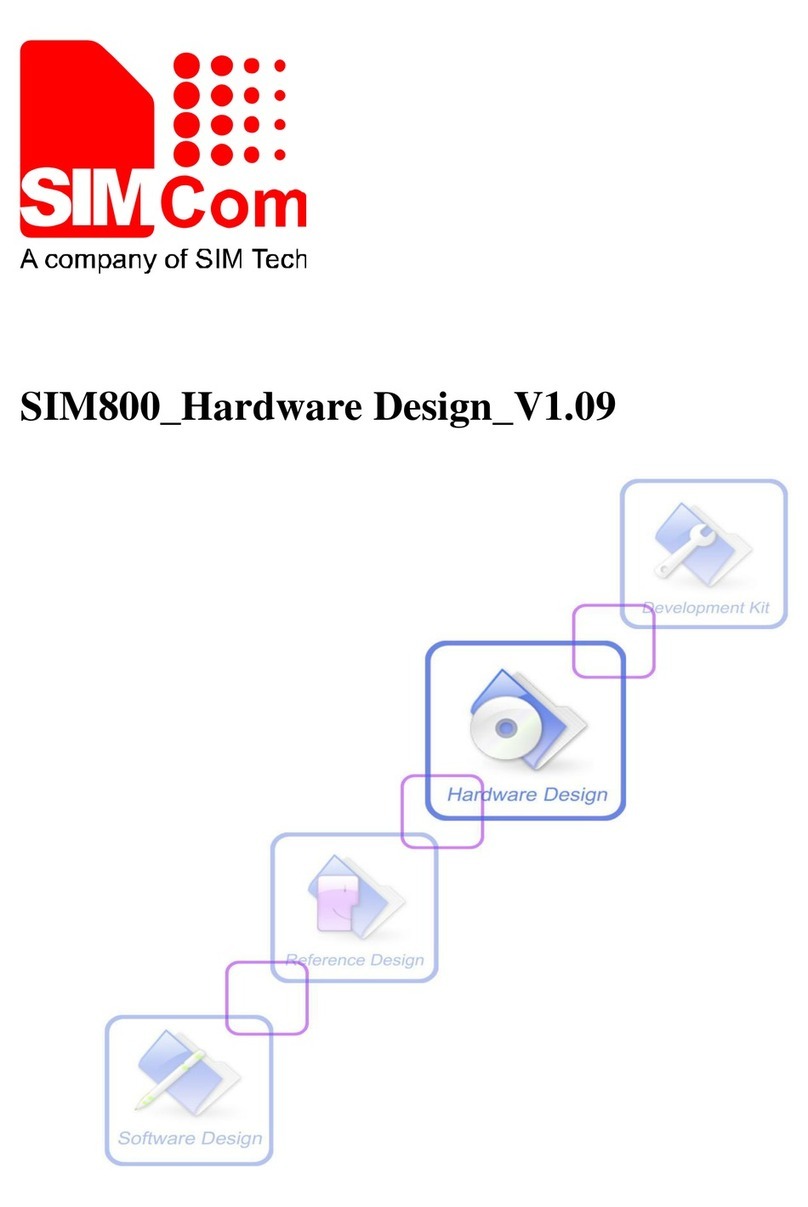
SimTech
SimTech SIMCom SIM800 Supplement
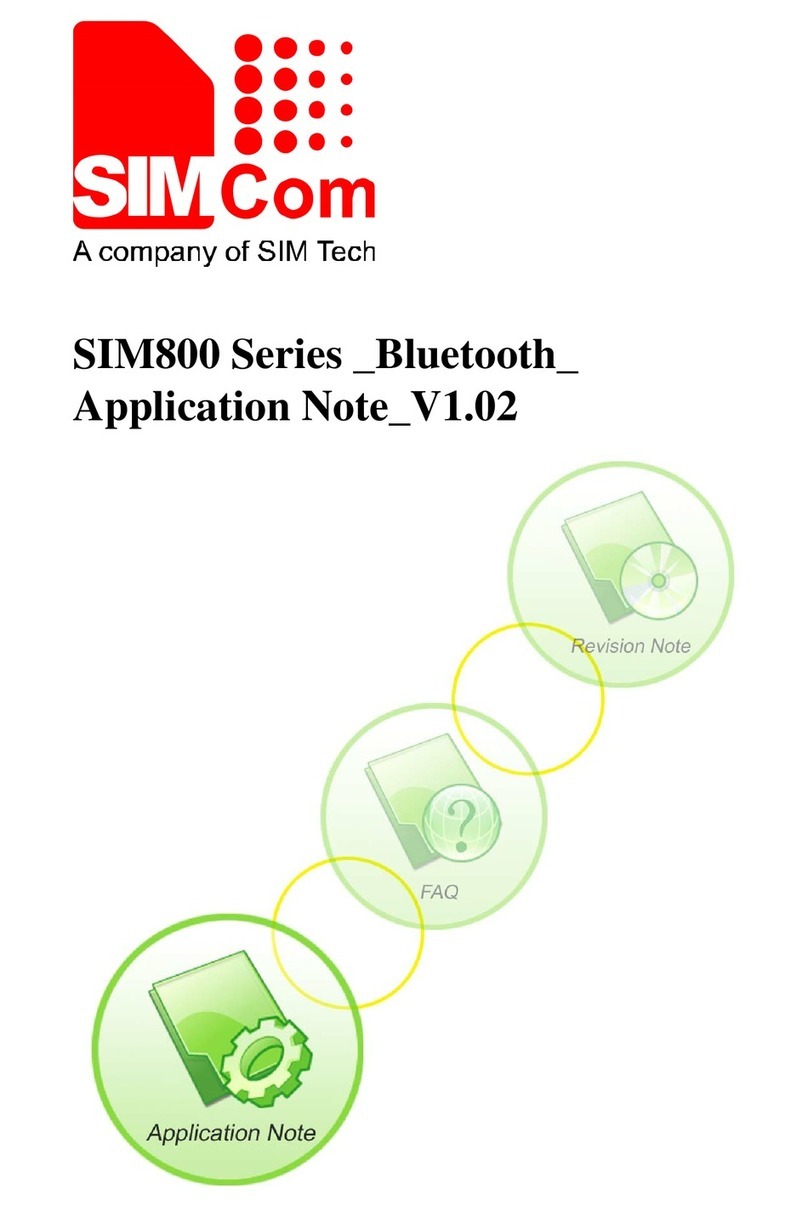
SimTech
SimTech SimCom SIM800 Series Supplement
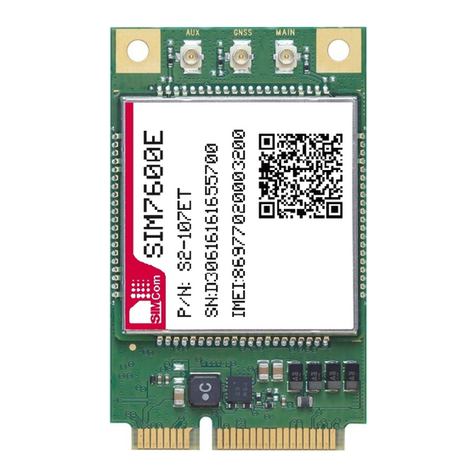
SimTech
SimTech SIMCom SIM7600E-PCIE Supplement

SimTech
SimTech SIMCom SIM800C Supplement

SimTech
SimTech SIMCom SIM7100-PCIE Supplement
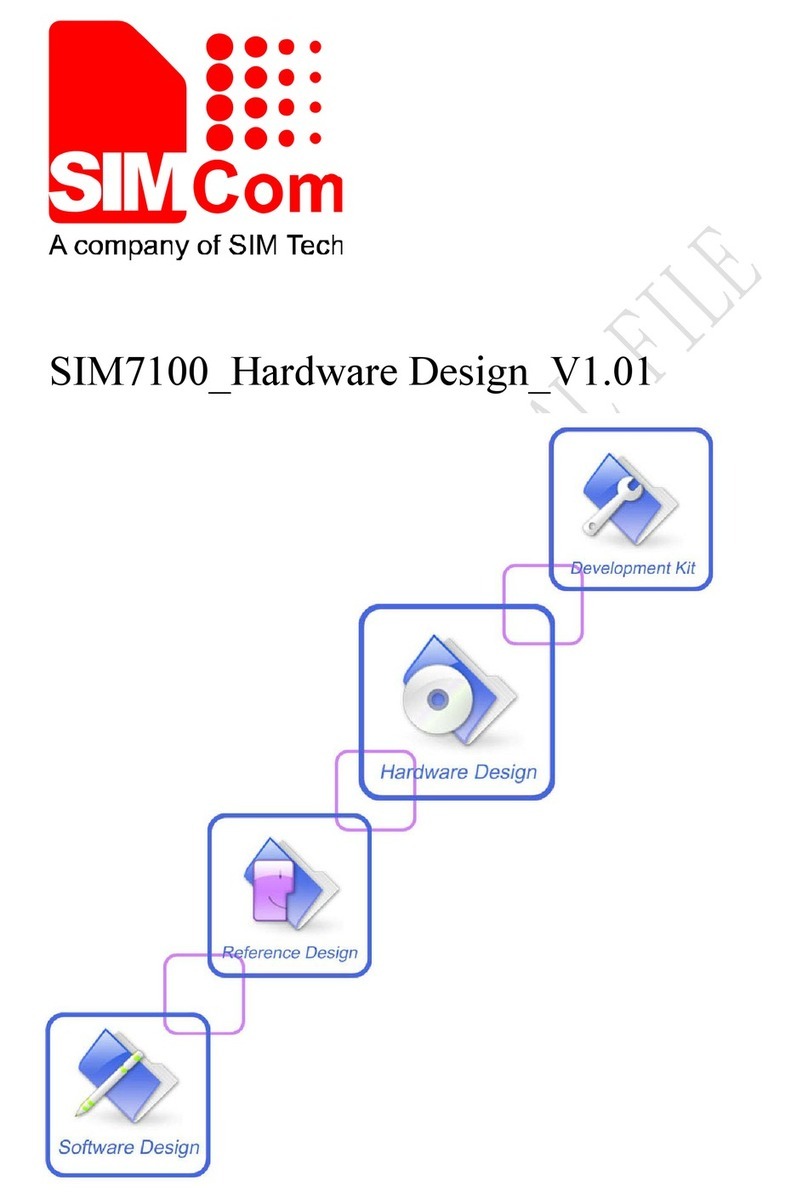
SimTech
SimTech SimCom SIM7100 Supplement
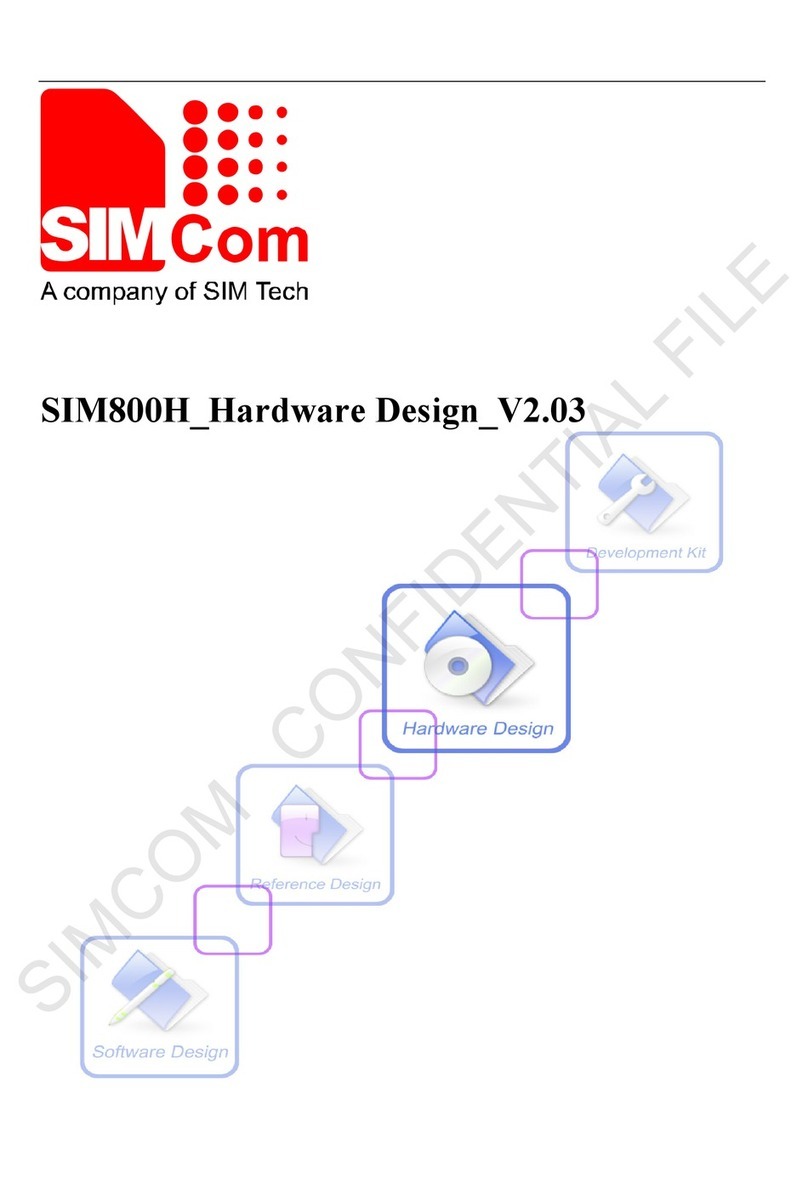
SimTech
SimTech SIMCom SIM800H Supplement
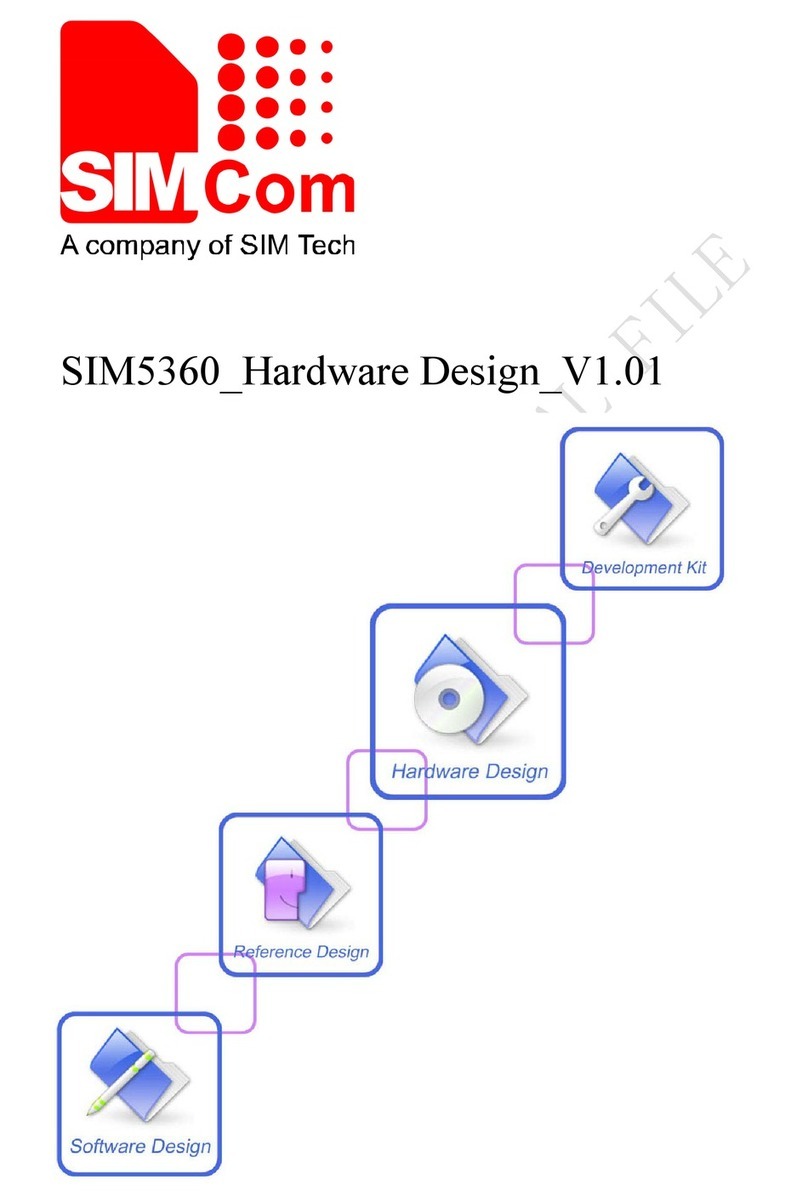
SimTech
SimTech SIMCom SIM5360 Supplement

SimTech
SimTech SIMCom SIM5360 Supplement
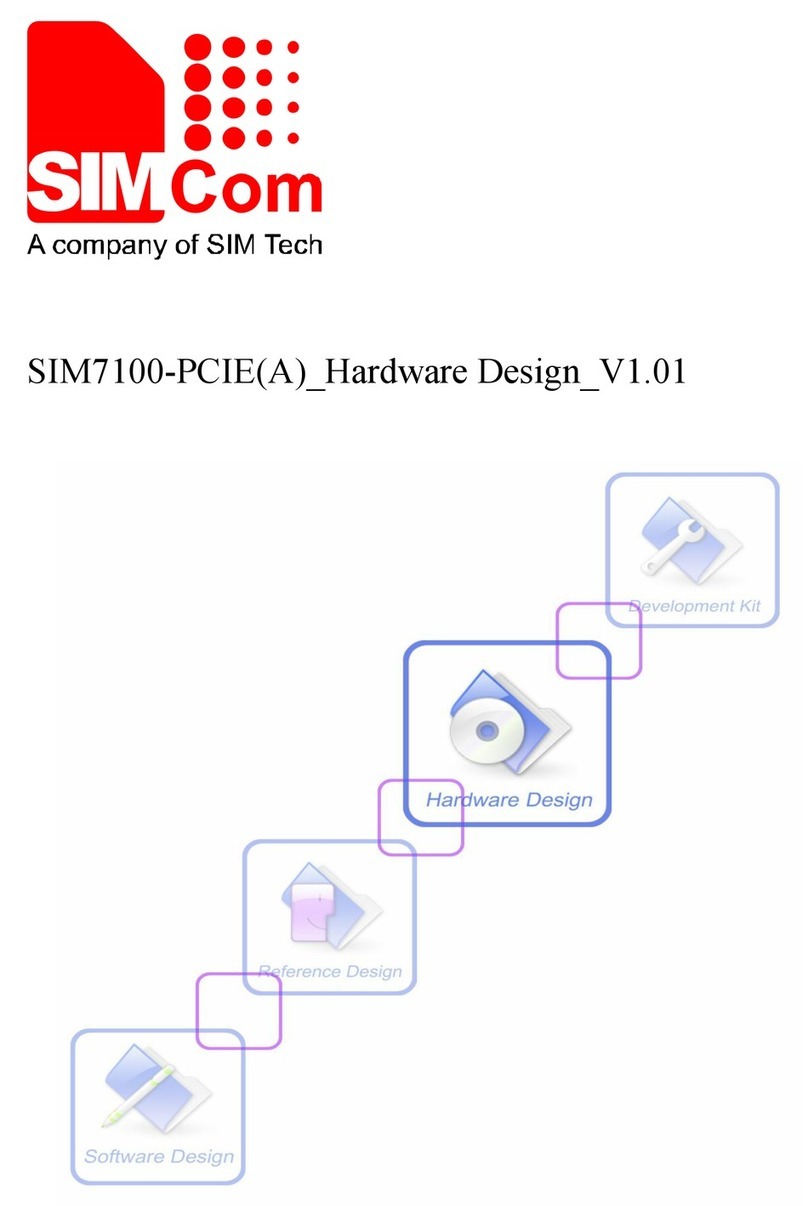
SimTech
SimTech SIMCom SIM7100-PCIE Supplement
